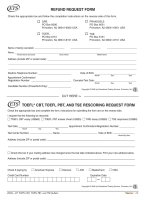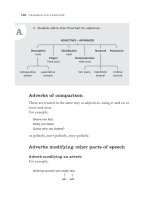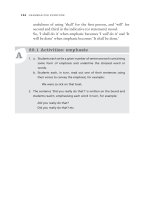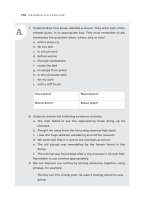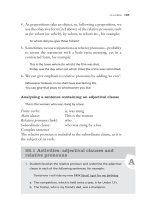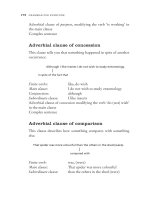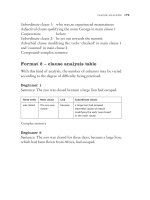Tài liệu Grammar for everyone part 25 ppt
Bạn đang xem bản rút gọn của tài liệu. Xem và tải ngay bản đầy đủ của tài liệu tại đây (150.06 KB, 7 trang )
A
7. Students draw four boxes, labelled as shown. They enter each of the
phrases given, in its appropriate box. They must remember to ask
themselves the questions when, where, why or how?
a. with a sharp cry
b. far too late
c. in a loud voice
d. before sunrise
e. through carelessness
f. under the bed
g. to escape from prison
h. in the rainwater tank
i. for my aunt
j. with a stiff brush
time (when?) Place (where?)
Manner (how?) Reason (why?)
8. Students rewrite the following sentences correctly.
a. The man failed to see the approaching horse doing up his
shoelace.
b. The girl ran away from the fierce dog wearing high heels.
c. I saw this huge skeleton wandering around the museum.
d. We were told that it is rare to see wombats at school.
e. The old plough was remodelled by the farmer found in the
dump.
f. The criminal was found dead after a trip overseas in his own bed.
Remember to use commas appropriately.
9. We can improve our writing by joining sentences together, using
phrases, for example:
The boy ran into a lamp post. He wasn’t looking where he was
going.
158
G r A M M A r f o r e V e rY o n e
C
A
Not looking where he was going, the boy ran into the lamp
post.
a. The farmer started digging up his paddock. He had heard that
there were dinosaur bones in the area.
b. Two men smashed into the video store yesterday. They used a
hammer to break the glass.
c. Michael spent the last of his pocket money. He bought a blue
vase. It was for his mother.
d. This elephant charged. He came towards us. His tusks were really
long.
e. The workers got very sunburnt. They were stripped to the
waist.
10. Students complete orally or in writing the following sentences, for
example:
I really like (walking in the rain).
I try to avoid (being late for dinner).
a. I really like . . . . . . . . . .
b. I try to avoid . . . . . . . . . .
11. Students change around and rewrite one of each of the above, so
that the noun phrase comes at the beginning of each sentence.
Checklist: phrases
Students should now be able to:
• recognise and mark phrases in a passage
• distinguish between the three kinds of phrases
• use phrases correctly and without ambiguity in their own writing
• label sentences containing phrases and indicate which words they
qualify or modify
159
p h r A s e s
160
Clauses
Definition: The word ‘clause’ is from the Latin clausa meaning
‘a closing’ – in the sense that the clause is complete in form and
meaning. A simple sentence with one finite verb is referred to as
the main (or principal) clause and the appended or attached clauses
are referred to as subordinate clauses.
Before studying clauses, students should:
• understand and recognise the difference between finite and
non-finite verbs
• know the functions of nouns, adjectives and adverbs
• understand the terms subject, object and complement
• be able to define the term ‘phrase’ and understand its
functions
• recognise and understand the function of relative pronouns
Once students have mastered the use of phrases they are well
on the way to understanding clauses. Clauses are used in the same
three ways: as nouns, being subjects, objects or complements; as
adjectives, qualifying nouns; and as adverbs modifying verbs.
It is important to identify for students the essential differences
between phrases and clauses.
A finite verb
A clause always contains a finite verb.
For example:
The old lady, carrying a newborn lamb, entered the kitchen.
non-finite verb (phrase)
26
The old lady, who was carrying a newborn lamb, entered the kitchen.
finite verb (clause)
A finite verb has a subject. The subject in the above clause is
expressed by the pronoun ‘who’, referring to the old lady.
A connecting word
Unlike phrases, clauses almost always need a connecting word. It
is occasionally omitted in casual speech, as understood. Adjectival
clauses are connected to the nouns they qualify by relative pro-
nouns (see page 164).
For example:
This is the hat that (or which) I bought at the market.
Adverbial clauses are connected to the verbs they modify, by a
subordinating conjunction.
For example:
I bought it because I am going to a wedding.
Noun clauses are connected by relative pronouns or
subordinating conjunctions.
For example:
My cousin told me what I should wear.
relative pronoun:
My cousin asked me when I would arrive.
conjunction
Whereas most of these connectors come naturally to native
English speakers, they can be more tricky for foreigners learning
English. It is important for students to understand the function of
relative pronouns before they practise clauses.
161
c l A u s e s
162
G r A M M A r f o r e V e rY o n e
Much jargon surrounds the terminology for all of these cate-
gories. As mentioned earlier, it is wise to use easily recognisable
but definitive terms, usually of the more traditional kind which
are readily understood in any language or reference material. It is
equally important to be consistent in their use.
Main clauses
The main (another common term is ‘principal’) clause consists of a
simple sentence with one finite verb. It makes complete sense.
For example:
A bee stung the woman.
finite verb
Compound sentences
There can be more than one main clause in a sentence. If the clauses
have the same grammatical form and are joined by a conjunction
such as and, or or but they form a compound sentence.
For example:
A bee stung the woman and she dropped her spade.
finite verb finite verb
Each clause makes sense on its own. The conjunction may be
only understood, in which case a semicolon is used to join the
main clauses.
For example:
A bee stung the woman; she dropped her spade.
Sentence analysis
Finite verbs: stung, dropped
Main clause 1: a bee stung the woman
